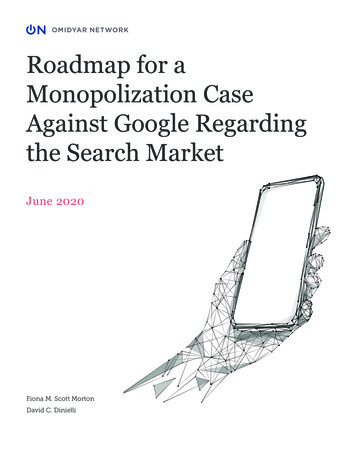
Transcription
Roadmap for aMonopolization CaseAgainst Google Regardingthe Search MarketJune 2020Fiona M. Scott MortonDavid C. Dinielli
BiographiesFiona M. Scott MortonFiona M. Scott Morton is the Theodore Nierenberg Professor of Economicsat the Yale University School of Management (SOM) where she has beenon the faculty since 1999. Her area of academic research is industrialorganization, with a focus on empirical studies of competition. Thefocus of her current research is competition in healthcare markets andthe economics of antitrust. From 2011-12 Professor Scott Morton servedas the Deputy Assistant Attorney General for Economic Analysis (ChiefEconomist) at the Antitrust Division of the U.S. Department of Justice,where she helped enforce the nation’s antitrust laws. At Yale SOMshe teaches courses in the area of competitive strategy and antitrusteconomics. She served as Associate Dean from 2007-10 and has wonthe School’s teaching award three times. She founded and directs theThurman Arnold Project at Yale, a vehicle to provide more antitrustprogramming and policy projects to Yale students. Professor Scott Mortonhas a BA from Yale and a PhD from MIT, both in Economics. She is afrequent speaker at seminars and conferences across the United Statesand Europe.Theodore NierenbergProfessor of EconomicsYale University School ofManagementAs a senior advisor with the beneficial technology team at OmidyarNetwork, David is focused on developing a robust analytic framework forantitrust litigation and regulation designed to reduce the competitive,democratic, and other harms caused by big tech companies.Prior to joining Omidyar Network, David served as deputy legal directorwith the Southern Poverty Law Center with a special focus on overseeingthe LGBTQ Rights & Special Litigation practice group. Previously, he was apartner with the law firm of Munger, Tolles & Olson, where he maintaineda national trial and appellate practice focused on antitrust, intellectualproperty, and corporate litigation. David has also served as special counselwith the Antitrust Division of the U.S. Department of Justice, helping tolead a forty-five-member team of attorneys in the successful antitrustchallenge to the proposed merger of AT&T and T-Mobile.David holds an A.B., magna cum laude, in classics from Harvard College,and a J.D., magna cum laude, from the University of Michigan Law School.David C. DinielliSenior Advisor,Beneficial TechnologyOmidyar NetworkAcknowledgments:Omidyar Network and the authors thank Gene Kimmelman, Charlotte Slaiman, and Alex Petros, with Public Knowledge,for their advice and significant contributions to the research and development of this policy paper.i
Table of ContentsBIOGRAPHIES . IINTRODUCTION. 1THE BUSINESS MODEL OF SEARCH AND RESULTINGFINANCIAL INCENTIVES .4MARKET DEFINITION.8General search is a relevant market. 8Specialized search is a limited constraint on general search. 10General search is the gateway to specialized search and generates a large percentage ofGoogle’s revenue. 10Amazon is a small constraint in shopping.11Syndicated search engines are partners not competitors. 12“Licensable smart mobile OS” is a relevant product market . 12MARKET POWER.13Google has high market shares . 13General search is a duopoly market. 14Google’s reach is 95%. 14Google’s financial returns are above competitive levels. 14Google identifies Bing as its only competitor. 15Google has the power to degrade ad quality and user experience. 15BARRIERS TO ENTRY.16Google has a strong brand. 17Google has website tags on 88% of sites compared to 1% for Bing. 17Google benefits from scale and indirect network effects. 18Google has access to location data (from the Android Operating System, Google Maps,and other apps)—a key entry barrier for advertising. 18Google has access to user data taken from the Android operating system and otherGoogle services. 19Google has a web index that is 500–600 billion pages. 19Google benefits from default bias on the part of users combined with default or preferentialplacement or pre-installation of browser, search box, and search engine. 21Defaults are entry barriers and re-enforce Google’smarket power.22Access to consumers would be expensive for a new entrant.23Google has exclusive contracts with Apple, android handset makers, and mobile networksthat deter entry.23Network effects act as a strong barrier to entry in licensable mobile operating systems.23ii
PROBLEMATIC CONDUCT. 241. Defaults and exclusive contracts.242. Android contracts (MADA and AFA).263. Acquisitions that denied scale to competitors. 314. Foreclosure of nascent competitors that rely on Google Search for traffic.325. The gateway. 336. Local search. 35HARMS. 36POTENTIAL REMEDIES. 39CONCLUSION.41iii
IntroductionGoogle processes 3.5 billion searches per day.1 Thisnumber exceeds by orders of magnitude the number ofsearches conducted by any other search engine. Thispaper explores why this is. How did Google becomeso dominant in search and who, if anyone, has beenharmed? Is it possible that Google has violated USantitrust law on its route to dominance?We explained in a previous paper how Google used itsdominant position in search to annex and occupy all the variousfunctions of what is called the “ad tech stack,” a term used to describe thecollection of entities that, collectively, facilitate the near-instantaneousauctions that allow websites to sell advertising space to advertisers whowant to advertise there. That paper was based largely on facts madepublic by the UK Competition & Markets Authority (CMA). The CMA isconducting an investigation into online platforms and digital advertisingin which it has gathered facts and data from UK market participants. TheCMA in December 2019 released an Interim Report that sets forth many of itsfactual findings and initial conclusions.This paper, as did our prior one about the ad tech stack, relies in large part on facts about the UKmarket that the CMA made public in its Interim Report. Several enforcement agencies in the UnitedStates also are conducting investigations of Google’s conduct in the US, but none has released any facts orfindings. However, the European Commission investigated Google for anticompetitive behavior starting in 2015.2The Commission’s decision relied on documents collected from and interviews with those relying on Google’ssuite of services (such as Android phone manufacturers), Google’s competitors, and Google itself. We draw onfacts made public in connection with a 2017 decision by the EC finding that Google had improperly favoredits own comparison-shopping service over competing services and imposed exclusionary contract terms inconnection with its Android operating system.3 Because of these actions, we have several sources to draw upon:the CMA interim report, the DG Comp documents from the EC, and a leaked memo from an FTC investigationthat concluded in 2013 (only every other page of which was visible).4 We use these materials to try to answerthe questions antitrust lawyers and economists are likely to ask, including, for example, questions about marketshares, barriers to entry, evidence of injury to competition, and the like. Of course, if US facts are different fromthose we rely on here, our answers and analyses might change.The facts we examine below are, in some ways, unsurprising: Google has a vastly dominant market share ofthe search market, however defined or measured, and therefore also has market power. But understanding how1234See Maryam Moshin, 10 Google Search Statistics You Need to Know in 2020, Oberlo (Apr. 3, 2020), cs.Press Release, European Comm’n, Antitrust: Commission sends Statement of Objections to Google on comparison shopping service;opens separate formal investigation on Android (Apr. 15, 2015), /en/IP 15 4780.If facts in the US are markedly different than they are in the UK or in Europe, our analysis of course could change. We see no obviousreason that would be the case, however, given that Google Search operates a global business and faces the same fundamentaldynamics and incentives regardless of geography. In addition, we are aware the FTC investigated allegations that Google unfairlygave preference to its own shopping and other services and issued a decision in 2013 declining to proceed with enforcementproceedings. See Statement of the Federal Trade Commission Regarding Google’s Search Practices In the Matter of Google Inc., FTCFile Number 111-0163, January 3, 2013. The FTC declined to proceed because it believed the evidence suggested that Google engagedin self-preferencing in order to improve its search results rather than to disadvantage rivals to its own specialized services. Seeid. at 2. We view the facts regarding Google’s disadvantaging specialized search engines differently than the FTC did. To us, thosefacts appear to be part of a larger pattern and strategy of denying scale to potential rivals in general search rather than simple unfairself-preferencing of its own specialized services. The conduct the FTC examined in 2011-2012 is similar to some of the conductwe examine here. But we view these facts through the lens of hindsight in which it now is clear that Google’s preferencing its ownservices may have been more valuable to it as a way to deny scale to potential horizontal rivals, rather than simply as a means tocapture profits in a particular vertical. The 2013 FTC Google decision therefore does not alter our analysis.The leaked FTC memo was published in the Wall Street Journal but only includes every other page. The FTC Report on Google’sBusiness Practices, Wall St. J. (Mar. 24, 2015), http://graphics.wsj.com/google-ftc-report/.1
Google rose to dominance and the reason its methods likely were anticompetitive is not as obvious. It requiressome understanding of the idiosyncratic economics at play in the search market—economics that result fromthe interplay between the fact that search engines are ad supported and the fact that they benefit in unusual waysfrom scale. We explain in the paper how Google took advantage of this interplay to disadvantage and exclude itsrivals and potential rivals from the market.Search markets work as follows: search engines build vast indices of web pages from the searchable web. A usertypes a search query and the search engine uses algorithms to select web pages (that it has cached and indexed)that then are listed on a results page. Those are called “organic results.” Search companies can also serve ads thatare prompted (for the most part) by the words or phrases that appear in the search query. A search for “roofer”yields a series of paid advertisements for—you guessed it—roofers. These “search ads” generally appear above andbeside the organic results.Search engines have a financial incentive to hone their algorithms so that they produce “relevant” results, fora number of reasons. First, if the user finds what she is looking for after just one search (as evidenced by, forexample, her clicking on a single organic result and then going on her merry way), she is more likely to return tothat same search engine for subsequent searches because it gave her exactly what she wanted. And the more oftenshe returns to that search engine to conduct a search, the more ads the search engine can show to her. Second,the search engine can charge more money for advertising if it is really good at serving relevant ads to the rightpeople, i.e., people who are most likely to click on those ads and make a purchase as a result.The thing about relevance, though, is that the only way to get good at it is to have lots and lots of people runningsearches on your search engine. Search engines “learn” from the behavior of the people running searches,including by monitoring how the users respond to and interact with search results. If very few people who type“roofer” click on an ad or an organic result the search engine selects for them about plumbing, then the searchengine will learn over time not to select ads or results about plumbing. The reverse is obviously true as well. Thesearch engine over time will learn what results are most relevant for particular searches if a lot of people click onthose results. Because of this, search engines have a tremendous incentive to grow their scale—that is, the numberof people conducting searches on their engine. The more searches, the more relevant the search engine can makethe results; the more relevant the results, the more likely the engine is to attract additional users and searches; themore users and searches, the more relevant the future results. The CMA calls this a “feedback loop.” In economicterms, the increase in scale leads to an increase in quality, and the increase in quality leads to further increases inscale. And while this “feedback loop”5 is playing itself out, of course, the engine becomes increasingly attractive toadvertisers and can charge increasingly high prices for advertising.The feedback loop can eventually weaken, however. Additional queries start to provide less and less newinformation. At some point, additional searches don’t help the search engine increase the relevance of its resultsbecause, in lay terms, there have been so many searches that the search engine has learned all there is to know.This pattern is called diminishing marginal returns. Given a moderately common search, a search engine withmany users might reach the point of diminishing returns quickly, whereas a very small search engine might takemuch longer to reach that point or never reach it at all because it just doesn’t have sufficient scale. It therefore is avery good thing from a competitive standpoint to be large rather than small. The large search engine generally canmonetize searches at higher prices than the small engine. In other words, it’s often the case that the scale of thelarge search engine allows it to determine relevance better and match to the right ad for a higher price than thesmall search engine.Lots of businesses benefit from scale; that is not unusual. But what is unusual about the search market in particularis that the large search engine actually has a financial incentive to deny scale to its smaller competitors or potentialcompetitors, not just gain scale for itself. This is why: search engines generally must pay “traffic acquisition costs”to get people to use them and build scale. An example would be a payment to be the default search engine for aparticular web browser. In order to obtain the traffic from that browser, a search engine would be willing to payan amount that reflected the expected value to it of the ads it could serve there. For a small search engine, this is5See Competition & Mkts Auth., Online Platforms and Digital Advertising: Market Study Interim Report ¶ 3.135 (2019) (“Strong sameside network effects lead to feedback loops. More users joining the platform leads to still more users joining, whilst users leaving theplatform leads to still more users leaving.”) [hereinafter “CMA Report”].2
the monetization level at the scale the default position would bring. Thelarge engine is willing to bid more than this level, if, due to its scale, itcan monetize at a higher price, meaning this additional tranche of usersis more valuable to the large engine than to the small one. Therefore, thelarge engine will tend to win a bidding contest for that traffic.But let’s say the small engine for some reason secures the default positionand gains additional users, and thus scale. Because of the additional scale,it then will be able to monetize all of its users at a higher rate (because ofthe feedback loop between scale and quality and its effect on price). Nowthe small engine is a more vigorous and stronger competitor. The nexttime an opportunity to acquire traffic arises—another browser defaultposition becomes available, for example—the small engine will be willingand able to pay more per user this time than before. If the large searchengine wants to win the second tranche of users by outbidding the smallsearch engine, it has to pay more than it would have if it had preventedthe small search engine from winning the first tranche in the first place,because it must outbid the small engine’s (relatively) higher price.This pattern could continue. Any time a small search engine gains scale,that would have the effect of raising the large search engine’s trafficacquisition costs going forward and eating into its profits, because it wouldhave to outbid the higher price the now-medium-sized engine can bid asa result of its increased scale. This is why the large search engine has anincentive to deny scale to its competitors, not just to gain scale for itself.In this way, Google’s incentives mirror those that led Microsoft to imposelicensing terms—deemed illegal by the U.S. Court of Appeals for the D.C.Circuit—that made it difficult for rival browsers to access customers.Those internet browsers did not themselves pose a direct threat toMicrosoft’s operating-system monopoly—they served a different functionand occupied a different market—but if they were to grow in popularitythey could bypass Microsoft’s operating system, thereby underminingMicrosoft’s operating-system monopoly.6 Microsoft had an incentive toprevent those competing browsers from gaining any scale at all in orderto maintain its monopoly. The facts we describe below show that Googlehas a similar incentive to restrict the growth of rival search engines andspecialized search to maintain its lucrative monopoly in search.Any time a smallsearch engine gainsscale, that wouldhave the effect ofraising the largesearch engine’straffic acquisitioncosts going forwardand eating intoits profits.Based on the evidence that has been made public in all of theseinvestigations, it appears that Google has acted on this incentive for manyyears, to the detriment of its competitors and its potential competitorsin search (including specialized search engines), to advertisers, and tocompetition and consumers. We describe in the paper four categoriesof potentially anticompetitive conduct that denied scale to competitorsor potential competitors, or, at the least, disrupted the feedback loopbetween scale and quality that might have allowed these other searchengines to prosper:6See United States v. Microsoft Corp., 253 F.3d 34, 60 (D.C. Cir. 2001) (“Therefore,Microsoft’s efforts to gain market share in one market (browsers) served to meet thethreat to Microsoft’s monopoly in another market (operating systems) by keepingrival browsers from gaining the critical mass of users necessary to attract developerattention away from Windows as the platform for software development.”).3
1.Google obtained default positions and exclusive default positions on home screens and with browsers thatdenied scale to rivals.2.Google developed the branded Android operating system, then made it available to handset manufacturersand wireless carriers on the condition that they disadvantage or exclude rival search engines, which deniedthose rivals the ability to obtain scale.3.Google acquired companies that provided valuable inputs to horizontal rivals that might have allowed thoserivals to increase quality and attract traffic. Google’s purchase of those companies undermined the ability ofthe rivals to rely on those companies to help build scale.4.Google manipulated its search results and exercised its market power in other ways to disadvantagespecialized search engines, all of whom are potential rivals, and all of whom (because users often get to thesesites through Google searches) rely on Google for traffic and thus scale.Some of this conduct may have created a monopoly position for Google; this is an issue we cannot address in thispaper because it requires access to too many facts that are not public. What seems plain from the public evidence,however, is that the anticompetitive conduct of Google allowed it to maintain its monopoly without needing tocompete on the merits.This paper will address potential remedies only briefly, but we generally want to emphasize that, because ofGoogle’s market power and significant barriers to entry, the search market is not going to correct itself. GivenGoogle’s immense advantage in scale, the complex web of exclusive contracts it has woven involving its ownoperating system and handset OEMs and wireless carriers, it seems a new entrant might need to develop notjust its own web index and search algorithm, but maybe in addition its own operating system or even handset.And it also would need to come to the battle armed with the billions and billions of dollars necessary to buy backfrom Google the users and scale that Google acquired through anticompetitive behavior. Alternatively, we couldimagine a more competitive market in which Google were prevented from disadvantaging rivals includingspecialized search engines that rely on it for traffic; those specialized search companies and other rivals mightthen be able to sell high-value advertising and erode some of Google’s monopoly profits or expand into otherprofitable verticals.This much, though, is clear. We do not know what the search market might look like today if Google had notengaged in anticompetitive conduct for years. But given the importance of search to all of our lives,7 it’s time wefound out.The Business Model of Search and ResultingFinancial IncentivesThe early days of Google could have been stolen from a Hollywood screenplay. Two Stanford students, Larry Pageand Sergey Brin, built a search engine for the World Wide Web in their dorm rooms. Originally named “Backrub,”later changed to Google, the two launched a company with a mission “to organize the world’s information andmake it universally accessible and useful.”8 While today Google is everything from a mobile operating system toan email client, at its foundation, Google began as a search engine for the then-novel World Wide Web.The early foundation for Google Search can be found in a 1998 paper by then-students Page and Brin: “Theanatomy of a large-scale hypertextual Web search engine.”9 The Internet was designed as a decentralized network,with a seemingly infinite ability to expand with an equally infinite number of potential content creators. Thismade developing an indexing system for the Internet a daunting task. Page and Brin’s answer was a system theydubbed “PageRank.” PageRank used links to content as a way to order its search results. Pages are ranked higher if789Moshin, supra note 1 (noting 84% of people perform at least three searches a day).Google, About Google, Our Company, https://about.google/ (last visited June 15, 2020).Sergey Brin & Lawrence Page, The anatomy of a large-scale hypertextual Web search engine, Stan. Univ. Infolab (1998), in98Anatomy.pdf.4
there are more pre-existing links to them from high-quality sources. The example used in Page and Brin’s paperis a simple Google Search for “Bill Clinton.”10 The top result is to the whitehouse.gov domain due to the plethora ofother websites linking to this domain. PageRank, despite tinkering over time, remains the foundation of GoogleSearch to this day.The business of a search engine is to understand the query so it can deliver to the consumer the answer she islooking for. That both satisfies the consumer, and so holds her attention during the search, and also gives her areason to come back when she has another query. Holding the consumer’s attention allows the search engineto sell advertising that she will see. Another reason the search engine wants to understand the query is so thatit can create a good match between what the consumer is looking for and advertisers that can satisfy that need.Being able to offer advertisers valuable spots on the Search Engine Results Page (“SERP”) is how it earns revenueand sustains the business. If a consumer searches for “custom t-shirts birthday” she may be looking to purchasecustom t-shirts for a birthday party, which makes her a potential customer for t-shirt makers. The search enginewill generally be able to sell the ad spots on the results page at a higher price to makers of custom t-shirts than tomakers of another random product.11 By analyzing many of the same search, the search engine will learn e.g., thatconsumers who type such queries are likely to click on ads for a custom t-shirt maker, a retailer of birthday partysupplies, and a maker of custom decorations in certain proportions. This helps the search company market itsresults page to the right businesses and judge the relevance of both organic links and possible advertisers. It alsoraises the value, and therefore price, of the ads being sold. This concept of match quality between the consumerand the advertiser is often called “relevance“ and manifests itself in the price of the ad which is also sometimesreferred to as “monetization” or “profit per search.”The ability to charge high prices for ads that are well-matched to the searching consumer provides the searchengine with a strong profit motive to understand and respond to consumer queries. This activity has significantreturns to scale. The more often a consumer types in “custom t-shirts birthday,” the more instances the searchengine can study to learn what the consumer then chose to do. Did she click on an organic link, and if so, whichone? Which ad did she click on? The more queries a search engine sees, the better it can get at determining whatthe user is loo
Search markets work as follows: search engines build vast indices of web pages from the searchable web. A user types a search query and the search engine uses algorithms to select web pages (that it has cached and indexed) that then are listed on a results page. Those are called "organic results." Search companies can also serve ads that










